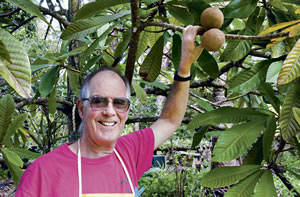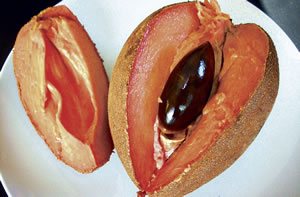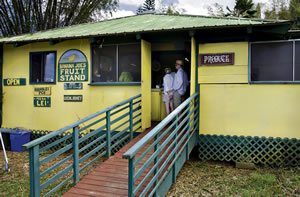Holy Moly, It’s Mamey Sapote
Joe and Cynthia Halasey are farmers and own Banana Joe’s Fruit Stand. The bright yellow store can be seen right off the highway, mauka side, in Kilauea. The store only sells local products (statewide), such as fruit and vegetables, fresh lei, honey, baked goods, prepared raw food and organic eggs. Their 5-acre farm also is on the property.“I started as a farmer doing dried bananas and I wanted to beat the middle man,” says Joe, who began farming on the property in 1979 and opened the fruit stand in 1986. “So I opened the fruit stand and now I’m more of middle man.”
What’s growing now: Bananas, cacao, coconut palms, dragon fruit, durian, egg fruit, mamey sapote, vanilla.
MAMEY SAPOTE
Native to Mexico and Central America, mamey sapote (mah-may sa-pohtay) are medium-large, dense fruit that weigh between 2 and 3 pounds. There is a large seed in the middle of the sweet and creamy flesh. With the texture of an avocado, it tastes like a combination of sweet potato and pumpkin, with undertones of almond, caramel, chocolate, honey and vanilla.
The word “sapote” is believed to derive from the Aztec word tzapotl, a general term applied to all soft, sweet fruits. It is considered a “delicious food in danger of extinction,” by Slow Food USA, and is catalogued in its “U.S. Ark of Taste,” a project dedicated to keeping endangered products “in production and on our plates.”The University of Florida lists 15 varieties of mamey sapote, and the Halaseys grow Pantin and Magana.
Season: Mamey sapote takes two years to go from flower to edible fruit. There are two harvesting times, January to April and June to September.
What to look for: If you see a scratch on the skin of the fruit, it’s because that’s the best way for farmers to tell if it’s ready to be picked. The fruit is mature if the newly exposed layer has turned from green to pinkish-brown, orange or red. If it’s green, it will never ripen.
Storage: Store at room temperature on the counter with good airflow. Once it’s cut open, store in the refrigerator, where it will keep for several days. You also can freeze the pulp for up to a year.
Preparation: To open a mamey, take a sharp knife and cut deeply into it. The knife will run easily through the pumpkin-colored flesh. Run the knife along the length, as you would an avocado. Remove the seed and stem. You can eat it like a papaya, and just spoon it out, or slice it. Once sliced, the skin easily peels off.
“The mamey are really good fresh,” says Joe, “but they make an excellent smoothie, because they’re very thick.”Mamey is used in desserts like milk shakes, ice cream, custards and puddings. It is also excellent for use in jellies, pastes and conserves. The seed can be milled to prepare a bitter chocolate.
Tip: Once picked, mamey sapote need five to seven days to further ripen. It is ready to eat when an impression remains after you press your finger on the fruit and the fruit begins to wrinkle. You want the fruit to be so soft that it will be flat on the bottom from sitting on the counter.
Health benefits: The nutritional composition of 100 grams of fresh mamey sapote is 107 calories; 1.0 grams protein; 0.5 grams fat; 28 grams total carbohydrates; 1.4 grams fiber; 22 milligrams calcium; 60 I.U. vitamin A; and 23 milligrams ascorbic acid (vitamin C). Beginning at age 15, males and females need 60 mg of vitamin C daily. Ascorbic acid got its name from a- (meaning “no”) and scorbutus (scurvy), a disease caused by a vitamin C deficiency. Vitamin C is a water-soluble compound that must be consumed through diet. The human body does not produce it. The adrenal glands use the most vitamin C, and the brain is the next biggest user.
Joe Halasey’s produce can be found at: Banana Joe’s Fruit Stand, 5-2719 Kuhio Hwy., Kilauea. For more information, call 828-1092.CHILLED MAMEY AND MANGO SOUP
One of the things I love about this column is that I get to introduce new produce. I had never seen a mamey before I met Joe Halasey, and I wanted to share a recipe that is delicious. Mamey is a big crop in Florida, and I adapted this recipe from one I found on the University of Florida website.
* 1 medium mamey
* 1 cup low-fat milk
* 2 cups mango, pureed
* 1 cup plain low-fat yogurt
* 1 cup unsweetened coconut milk
* 2 tablespoons lime juice
* 1 tablespoon ancho chili powder
* 1/2 teaspoon ground cumin
* 1/4 cup chopped fresh mint leaves
* Dark Koloa Rum (optional)
In a large bowl, whisk together the mamey mixture, yogurt and coconut milk. Season with lime juice, chili powder and cumin, then mix in the mint and refrigerate for at least 1 hour before serving.
Ladle the soup into four large bowls. Divide the mamey cubes into each bowl of soup and float a splash of rum on top.








